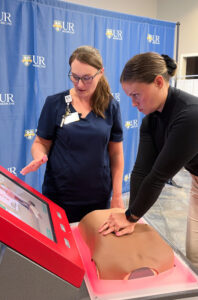UR Medicine and American Heart Association Improve CPR Readiness
By Deborah Jeanne Sergeant

UR Medicine wants more people to know how to perform cardiopulmonary resuscitation (CPR) in an emergency situation.
Working with the American Heart Association, UR Medicine has developed several efforts to aid the community in become heart emergency savvy.
Learning about CPR is so important because victims’ chances of surviving a cardiac arrest double when they receive CPR.
“CPR is undeniably the best response when someone suffers cardiac arrest,” said physician Spencer Rosero, interim chief of UR Medicine Cardiac Care.
More than 350,000 people annually — nearly 1,000 daily — experience cardiac arrests away from a hospital setting, according to the American Heart Association. Performing CPR helps keep life-giving blood flowing throughout the body to decrease risk of neurological damage and death.
Only 32% of people in Monroe and Livingston counties who experience a heart attack at home received CPR before the ambulance came. The national target is 45%. That’s why UR Medicine launched mobile hands-only CPR training kiosks around the area to help passersby learn the lifesaving skill.
In addition, UR Medicine is supplying CPR training kits at Monroe County libraries for small group or individual learning opportunities.
The kiosks include a touchscreen with a video that offers a training session and chance to practice on a built-in rubber torso manikin. This aspect helps learners know where to place their hands, how hard and deeply to compress and the correct rate. The device’s real-time response helps people improve their CPR technique.
“Less than half of all people who need CPR receive it from bystanders before professional help arrives,” said Jason Stulb, executive director of the American Heart Association, Rochester. “Knowing how to respond in a cardiac emergency when seconds matter can be the difference between life and death. Thanks to UR Medicine, our ‘Life Fierce. Take Action.’ supporter, we are able to use innovative ways, like this mobile CPR kiosk, to improve the chances of surviving a cardiac arrest in our community. We are committed to creating a nation of lifesavers through training and education like this.”
Many people may see automated external defibrillator (AED) boxes at public places and conflate the purposes CPR and AED. Martina Landahl, registered nurse and master’s in nursing education, is part of the learning and development team at URMC, explained that AEDs and CPR complement each other.
“CPR is the first response we can do without any equipment,” Landahl said. “If someone collapses and isn’t breathing normally, you’d start CPR and of course call 911. Put your phone on speaker so the operator can guide you. We don’t say anymore to check for a pulse as many people don’t do it properly. We’re training more to look for breath, like the chest rising and feeling the breath.”
Trying to evoke a response by calling the person’s name or tapping on their shoulder can also indicate CPR is needed for the victim. If there’s no response, that’s when it’s time to start chest compressions and ask a bystander for the AED. Landahl said that the AED can determine what’s happening and deliver a lifesaving shock.
“Neither is wrong to do first,” Landahl said. “If you’re physically unable to do chest compressions, the AED can go first. The AED will guide you and let you know what this person will need.”
The equipment is made so that any layman can safely use it without any training (although training is available and helpful). Simply turning on the AED begins the automated process with both visual and audio guidance.
“It can analyze the heart rhythm and remind you to step back clear of the victim so you don’t get shocked yourself and it will tell you whether the person will require a shock and tell you to deliver the shock,” Landahl said. “The new machines have numbers to direct you what orders to do things, pictures, blinking lights to guide your eyes and it will deliver the shock. After that, the AED will remind you to go back to chest compressions. Even with all the training when something happens and most likely it’s someone you know and have a connection with, you may have a moment of not knowing what to do and fear. You should feel confident you can help in these situations.”
Although some people fear they’ll make things worse or be sued if the person dies, Landahl said that doing nothing is the worst thing to do.
“Good Samaritan” laws protect people who are acting in good faith to help people who are sick or injured, she said.

